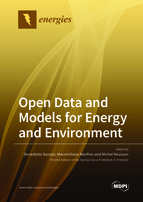Open Data and Models for Energy and Environment
A special issue of Energies (ISSN 1996-1073). This special issue belongs to the section "B: Energy and Environment".
Deadline for manuscript submissions: closed (15 February 2021) | Viewed by 40324
Special Issue Editors
Interests: building physics; building services engineering; building simulation; renewable energy technologies; indoor environmental quality; open data & energy analytics; energy efficiency; zero energy buildings; power-to-X solutions; buildings, district and national energy systems
Special Issues, Collections and Topics in MDPI journals
Interests: building physics; building services engineering; renewable energy technologies; data mining; operation research; analytics; sustainability transitions; energy transitions; open data; open science
Special Issues, Collections and Topics in MDPI journals
Interests: energy systems; transport; renewable energy sources; data analysis; open data; energy statistics; decarbonization; digitalization
Special Issues, Collections and Topics in MDPI journals
Special Issue Information
Dear Colleagues,
Following the success of the Special Issue “Open Data and Energy Analytics”, also published as an e-book, we invite you to contribute to this second Special Issue focussed on Open Data and Models for Energy and Environment.
Cutting-edge solutions provided by Research and Development funded by the European and International Framework are of interest for this editorial initiative.
Energy engineers and planners must provide the simplest and most robust tools to collect, process, and analyse data in order to offer solid data-based evidence for future projections in building, district and regional system planning.
This Special Issue aims at providing recent advancements on open data and models. Energy and Environment are the fields of applications.
For all the aforementioned reasons, we encourage researchers and professionals to share their original works. Topics of primary interest include but are not limited to:
- Open data and models for energy sustainability;
- Open data science and environment applications;
- Open science and open governance for Sustainable Development Goals;
- Key performance indicators of data-aware energy modelling, planning and policy;
- Energy, water and sustainability database for building, district and regional systems;
- Best practices and case studies.
Dr. Benedetto Nastasi
Dr. Massimiliano Manfren
Dr. Michel Noussan
Guest Editors
Manuscript Submission Information
Manuscripts should be submitted online at www.mdpi.com by registering and logging in to this website. Once you are registered, click here to go to the submission form. Manuscripts can be submitted until the deadline. All submissions that pass pre-check are peer-reviewed. Accepted papers will be published continuously in the journal (as soon as accepted) and will be listed together on the special issue website. Research articles, review articles as well as short communications are invited. For planned papers, a title and short abstract (about 100 words) can be sent to the Editorial Office for announcement on this website.
Submitted manuscripts should not have been published previously, nor be under consideration for publication elsewhere (except conference proceedings papers). All manuscripts are thoroughly refereed through a single-blind peer-review process. A guide for authors and other relevant information for submission of manuscripts is available on the Instructions for Authors page. Energies is an international peer-reviewed open access semimonthly journal published by MDPI.
Please visit the Instructions for Authors page before submitting a manuscript. The Article Processing Charge (APC) for publication in this open access journal is 2600 CHF (Swiss Francs). Submitted papers should be well formatted and use good English. Authors may use MDPI's English editing service prior to publication or during author revisions.








